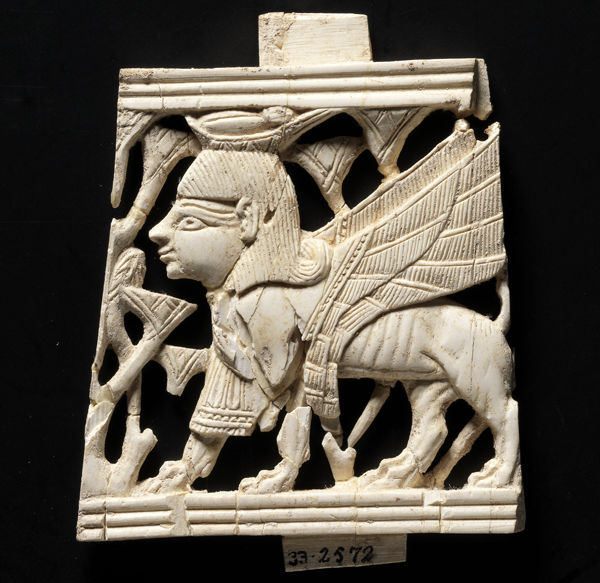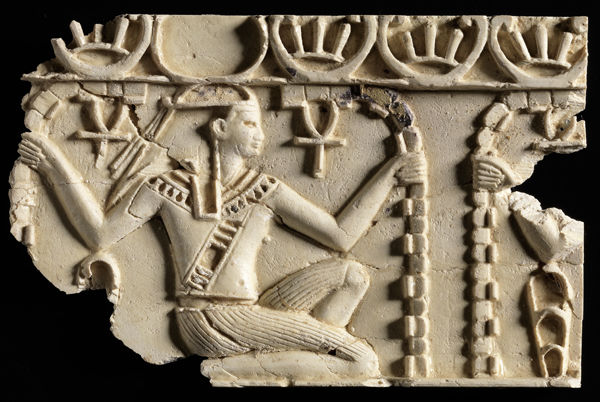The ancient Phoenician city-states (principally Tyre, Sidon, Byblos, and Arwad) lay along the coast and islands of modern-day Lebanon. In Greece and Rome the Phoenicians were famed as "traders in purple," referring to their monopoly on the precious purple dye derived from the shells of murex snails found along its coast. In the Bible they were famed as sea-faring merchants; their dyes used to color priestly vestments (Ex. 28:4–8), adornments, curtains, yarns, and fabrics used in the Temple of Jerusalem (Ex. 26:31; 36:35; 2 Chr. 2:6; 3:14; cf. Jer. 10:9). Archaeologically, we know that their trading networks extended from the Levantine coast to the Iberian Peninsula, linking ports in the Mediterranean into a vast mercantile network.
Phoenicia's independent city-states were squeezed between the Mediterranean coast and the Lebanese mountains. With a limited agricultural capacity, these city-states independently sought political alliances and trade agreements with neighboring lands to supply needed imports of cereals and oil.

Fig. 1. Carved ivory plaque with striding sphinx. ca. 9th–8th century b.c. Levant, Samaria. Israel Antiquities Authority (IAA 1933-2572)
The unification of the tribes of Israel under King David at the end of the eleventh century b.c. and a period of relative peace following the defeat of the Philistines provided the Israelite monarch the opportunity to initiate diplomatic contacts and develop a commercial agreement with Hiram, the ruler of the Phoenician city of Tyre: "King Hiram of Tyre sent envoys to David with cedar logs, carpenters, and stonemasons; and they built a palace for David" (2 Sam. 5:11). Later, when Hiram heard that Solomon, David's son, had succeeded his father as king, he sent envoys to Jerusalem to congratulate the new king and to propose extending their trade alliance. Solomon replied that he wished to build a grand house for "the name of the Lord," a project first proposed by his father. "Please, then, give orders for cedars to be cut for me in the Lebanon. My servants will work with yours, and I will pay you any wages you may ask for your servants; for as you know, there is none among us who knows how to cut timber like the Sidonians (i.e., Phoenicians)" (1 Kings 5:15–20). Further correspondence led to an accord in which Solomon guaranteed to provide, for an unspecified number of years, an annual amount of food for Hiram's household (1 Kings 5:23, 25) in return for the import of cypress and cedar logs and their transport by sea to a designated port. Solomon also employed Phoenician masons and stone cutters (1 Kings 5:31–32) to shape the blocks of stone used to construct the Jerusalem Temple's foundation.
After the completion of the temple and the construction of a palace, the two rulers sought to extend their pact. "Solomon gave to Hiram twenty towns in the region of Galilee . . . (and) Hiram sent the king one hundred and twenty talents of gold (ca. 66 lbs.)"(1 Kings 9:11–14). Solomon may have needed the new revenue, given the enormous expenses involved in building and furnishing his temple and palace with imported gold and cedar (1 Kings 9:11; 10:18; Josephus, Antiquities, 5:3), while Hiram sought the agricultural resources from new lands where there was already a significant Phoenician population.
In an additional agreement, the two rulers joined forces on a land and sea venture to open up new overseas markets. Solomon constructed a fleet of long-haul merchant vessels at a port on the shores of the Red Sea. Hiram provided the expertise of his mariners "who were experienced on the sea, to serve with Solomon's men" (1 Kings 9:27). The expedition was to reach the land of Ophir, located either in the vicinity of present-day Somalia or in southeast Arabia, to obtain gold that Solomon was to use to overlay his ivory throne and make drinking, cups, tableware, and shields for his Lebanon Forest House, a part of the royal compound in Jerusalem housing the treasury and armaments (1 Kings 10:18–21). The expedition also returned with precious stones and exotic woods (2 Chr. 9:10). Merchant ships continued to sail the Red Sea (2 Chr. 8:18) returning once every three years "bearing gold and silver, ivory, apes and peacocks" (2 Chr. 9:21). Presumably, the success of this enterprise and the fame of Solomon's court led to a visit by the Queen of Sheba "who arrived in Jerusalem with a very large retinue, with camels bearing spices, a great quantity of gold, and precious stones" (1 Kings 10:2,10; 2 Chr. 9:9). The Queen probably came to Jerusalem with the intention of establishing or strengthening ties with a Mediterranean trading partner. Overland camel traders from Arabia continued to ply their wares at the Israelite court for centuries to come (Ezek. 3:13) bringing many exotic aromatics and spices from across the desert (Song of Songs 3:6) in addition to gold and unnamed precious stones. Sweet smelling spices such as cinnamon were mixed with oils and used in Israel's cultic rituals (Ex. 30:23–25). Solomon's royal merchants also imported horses from Egypt and Cilicia and did business with the kings of Aram (1 Kings 10:27–29). At this time Tyre, with income derived from long-distance trade, also became a bustling commercial center with new port facilities, temples, and a royal palace. Unfortunately, no trace of its royal archives survive.
With the death of Solomon and the threat of civil war between the Israelite tribes of the north and south, the nation broke up into two separate states, Judah to the south and Israel in the north. Trade and alliances with Phoenician city-states continued, especially with the northern kingdom. A marriage between Ahab (873–852 b.c.), the sixth king of Israel, and Jezebel, a Phoenician princess, cemented political and commercial ties between Israel and Tyre (1 Kings 16:29–31).
Ahab constructed a magnificent palace atop a hill in Samaria, the capital of the northern kingdom. An exterior defensive casement wall constructed of Phoenician-style ashlar masonry surrounded the enclosure. Inside the palace, furniture was inlaid with Phoenician-style ivories, often with Egyptian motifs (1 Kings 22:39) (Figs. 1 and 2). For the prophet Amos, the finely hewn Phoenician-style stone blocks used in the homes of the elite and the ivories adorning their wooden beds symbolized the decadent lifestyles of wealthy Israelites (Amos 3:15; 5:11; 6:4; cf. I Kings 22:39). Ordinary people slept on floors covered with rush mats.

Fig. 2. Egyptian-style carved ivory plaque, ca. 9th–8th century b.c. Levant, Samaria. Israel Antiquities Authority (IAA 1933-2550)
With the rise of Assyrian military might in the ninth century b.c., the looming presence of attack, looting, and destruction by Assyrian armies was soon to change the political landscape of the Near East. Outnumbered, the Phoenician city-states agreed to pay tribute to Assyrian kings. According to agreements made with their suzerains, Tyre, in return for payment of gold, silver, tin, linen, monkeys, ebonite-wood, and wooden and ivory chests, was able to maintain commerce and colonization with its far-flung trade network. Their merchants, according to the prophet Isaiah, were to become "the great ones of the world" (Isa. 23:8). In the sixth century, Ezekial (27:12) describes Tyrian imports of iron, lead, tin, and silver from Tarshish (Spain). Jeremiah (10:9) describes beaten silver brought from Tarshish, and gold from Uphaz (location unknown). The fame and wealth of the city was remembered by the prophet Zechariah, who declared: "Tyre has built herself a fortress; she has amassed silver like dust, and gold like the mud in the streets" (Zech. 9:3). Israel, too, paid tribute to Assyria and the alliance between Samaria and Tyre. The prophet Amos denounced the Phoenician city for "ignoring the covenant of brotherhood" (Amos 1:9). Judah also paid tribute, and notices of commerce between Judah and Phoenicia disappear from the biblical record.
When Israel and the Phoenician city-states revolted in the eighth century b.c., the Assyrians destroyed the northern Kingdom of Israel in 722 b.c. and, except for Tyre, deported rebellious populations. Continued Assyrian assaults devastated many Phoenician cities and lands, leading the prophet Isaiah to mock Tyre and Sidon for their excessive self-confidence and lack of humility (Isa. 23).
By 640 b.c. Tyre had become a province of Assyria, with severe trading restrictions imposed on its commerce, while Phoenician colonies in the west continued to flourish. But with the fall of Assyria in ca. 612 b.c. and the emergence of Babylon as the new power center in the Near East, both Jerusalem and Tyre soon fell. Nebuchadnezzar (604–562 b.c.) defeated Judah, pillaged Jerusalem in 586 b.c., and exiled its elite. For thirteen years (585–572 b.c.) he laid siege to Tyre. When the city fell, its king was deported to Babylon. Soon afterward the Tyrian monarchy came to an end and the prophet Ezekiel (27:3, 36) proclaimed that those "who dwell at the gateway of the sea, who trade with the peoples on many coastlands . . . have ceased to be forever." In spite of the prophet's claim of Tyre's destruction, when Judean exiles returned to Jerusalem later in the sixth century they turned to Phoenicia, as had Solomon hundreds of years before, to obtain cedar wood to rebuild the temple (Ezra, 3:7).